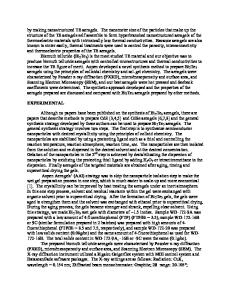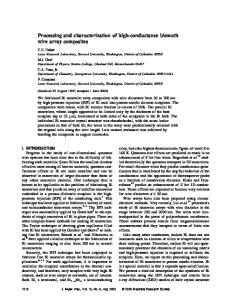Synthesis and Characterization of Bismuth Sulfide and Bismuth Telluride Nanorods and their Polyaniline Nanocomposites
- PDF / 213,337 Bytes
- 5 Pages / 612 x 792 pts (letter) Page_size
- 46 Downloads / 341 Views
S8.36.1
Synthesis and Characterization of Bismuth Sulfide and Bismuth Telluride Nanorods and their Polyaniline Nanocomposites Ven B. Reddy, Patrick L. Garrity and Kevin L. Stokes Advanced Materials Research Institute, University of New Orleans, New Orleans, LA 70148. We present here a simplified approach to the synthesis of bismuth sulfide and bismuth telluride nanorods and their polyaniline(PAN)-coated nanocomposites. The present method gives highly crystalline nanorods of bismuth sulfide of varying aspect ratio depending on the capping ligand employed, and involves reacting bismuth(III) trioleate with thioacetamide in phenyl ether at elevated temperatures in the presence of excess capping ligand. Bismuth telluride was obtained in high yields by reacting bismuth(III) trioleate with trioctylphosphine telluride at relatively low temperature. Oleic acid, sodium dodecylsulfonate and sodium dodecylbenzene sulfonate, used as capping ligands, did not have significant effect on the aspect ratio of Bi2Te3 nanorods. The nanostructured materials obtained this way were then coated with polyaniline (PAN) by heating a specific amount of material with half as much PAN in toluene close to reflux temperature for 6-8 h. It was necessary to keep the mixture thoroughly stirred and intermittently sonicated in order to ensure that the particles remain dispersed at all times. Bismuth chalcogenide nanoparticles as well as their composites were characterized using transmission electron microscopy and X-ray powder diffraction.
Introduction Our interest in nanophase bismuth chalcogenides originates from the expectation of improved thermoelectric properties in their nanophase compared to bulk material. Also, we expect to observe good thermoelectric behavior when these nanomaterials are coated with polyaniline to give core-shell structures. Theoretical modeling of these core-shell structures and the results obtained from their thermoelectric studies have been separately reported in other proceedings of this conference (MRS Conference Proceeding, 2003). This communication relates the synthesis and characterization of these materials. The continued interest in bismuth chalcogenides in thermoelectric applications is due to their desirable thermoelectric properties. Indeed, bismuth telluride is considered a benchmark standard for these applications. However, while there are many chemical approaches to the synthesis of bulk-phase bismuth chalcogenides, there have been relatively few methods to obtain their nanoscale congeners in highly crystalline form.1 Particularly, there was only one publication concerning the synthesis of nanophase bismuth telluride.1a Previous syntheses of bismuth sulfide nanorods employed hydrothermal-solvothermal methods1b, precipitation at high temperature1c, microwave irradiation1d, reacting precursors in polyols at high temperature1e, thermolysis of thiocarbamate precursors1f and a host of other methodologies. All these methods are characterized by several reaction components, the function of which is often times not cl
Data Loading...











